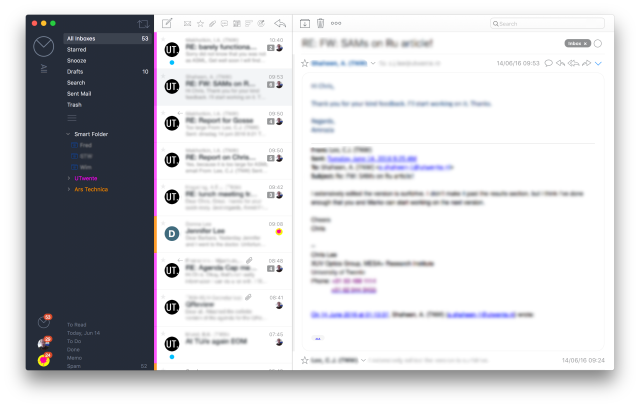
E-mail clients are a personal thing. Something I love is not necessarily something you love, and I'm okay with that. Maybe I'm just picky, but I am an equal opportunity hater when it comes to email clients, and I've tried quite a few. A couple of years ago I stumbled upon Airmail and never looked back. Bloop just released Airmail version 3.0 last month.
Back in the day I used Eudora, but I've also used Thunderbird, Outlook, and Apple's own Mail client. In Mac OS 9 days, I even tried out a client called Nisus Email. There are many more that have briefly messed up my inbox and then gone. I don't mind paying for an e-mail client, but it has to do its job the way I want it to. So what do I want it to do?
The first thing is that it should not be integrated with its own calendar or to-do list. This sounds strange, but I often find myself reading an e-mail that has a list of dates and times for a possible event. In an integrated client, I have to flip back and forth between tabs to really check those dates. Sure, you can usually get a mini-calendar to one side, but then you have to click through day-by-day. If the applications are separate, I can put them side by side and get a much clearer view. This works especially well when I have more than a single screen available.
On the other hand, an e-mail client should not be completely divorced from my calendar application. I should be able to handle meeting requests, but I want to be able to mix and match with apps I like rather than being forced to use an integrated option.
As for to-do lists, task lists should be associated with projects. E-mail is for communication. When I look at a task list, I want to have a specific project in mind. Combining this with an e-mail client blurs that line and allows the application to distract me from critical tasks. But, as with calendars, the e-mail client should be able to talk to my task list.
Finally, an e-mail should be reliable. When a word processor stops working, you know it, because three pages of unsaved text vanish into the ether. When an e-mail client stops working, everything goes silent, and it can take a while to notice. Or maybe some e-mails are being downloaded reliably while others go missing. This sort of unreliability makes me angry.
All of these requirements pretty much eliminate the major clients. Especially Apple Mail, which seems to believe you need an e-mail holiday once a week. So what does Airmail bring to the party? As you might expect from a modern e-mail client, it supports Exchange, IMAP, and older POP servers. Configuration is about as easy as it is for any other modern e-mail client.
Service integration
Airmail integrates smoothly with Apple's built-in calendar and with third-party calendar apps (I use BusyCal, but it also integrates with the OS X Calendar). It also integrates with OmniFocus and supports a number of other organizational applications, including Evernote and Dropbox. For cloud storage services the integration isn't particularly useful; Airmail simply uploads attachments to the cloud, something I'd rather not do. But all the other stuff is extremely simple.
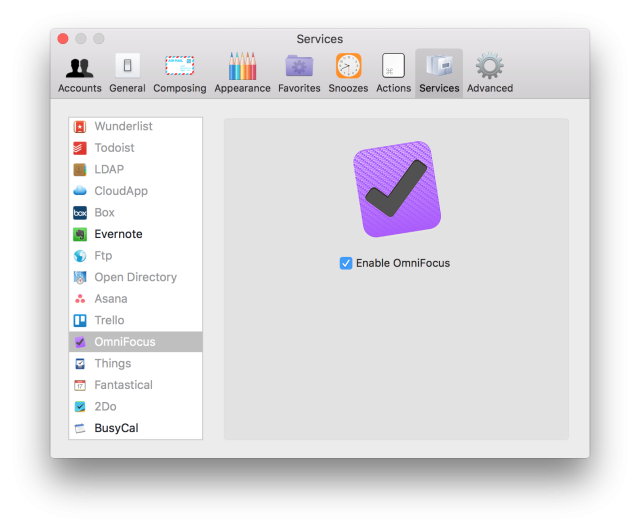
For example, adding a to-do item to OmniFocus can vary from two clicks to a more sophisticated operation where you can add information like due dates and project settings.. There are similar possibilities for the other services that I've not tried.
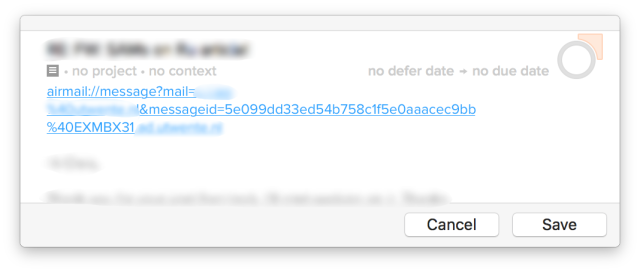
One-click filters
The second thing that Airmail does well is sort and filter e-mail. Like many clients, Airmail offers smart folders and a unified inbox. Smart folders are easy to set up if you want to use them, but Airmail has a great set of single click filters that are even more powerful than a smart folder.
I can select an e-mail and, with a single click, show only e-mail from the sender. Similar operations exist for attachments, conversations, and date ranges (more than a single click is required if you want a range rather than a single day). Using these filters in conjunction with each other generally allows me to retrieve any e-mail I am searching for. Filters are usually much faster than using a standard text search, because they are nearly instantaneous to add and remove. And for those occasions when you can't find an e-mail after filtering, Airmail has a standard text search box, which is about as good as any other e-mail search facility. Even better, the search works with the filters to make it even more powerful.

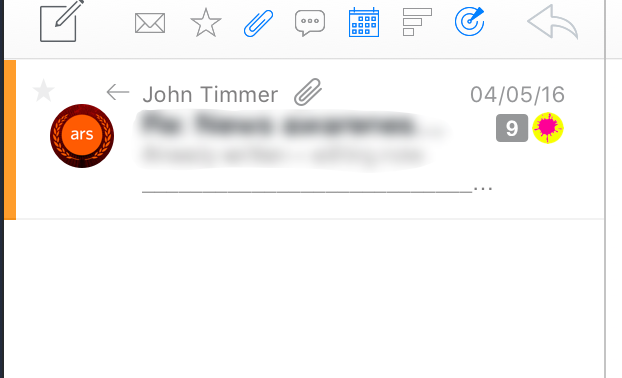
These filters have saved me a significant amount of time. The unread e-mail filter is especially useful. I usually try to return my unread e-mail count to zero twice a day. By only showing me unread e-mails, Airmail helps me focus on a task I'd rather be doing.
Another excellent feature of Airmail is the Airmail composer. If you click on the little sharing button that turns up in many Mac applications, the Airmail composer shows up in the share sheet. This attaches the document to an e-mail, allowing you the space to fill in the address information, a subject, and a short message, all achieved without leaving the application you were using. This is surprisingly speedy and pleasant to use.

Gestures and shortcuts
Airmail knows about the modern touchpad and comes with a range of configurable gestures. Practically every menu item has a shortcut. Ever since gestures turned up in OS X, I've tried repeatedly to use them, but I never seem to remember more than a couple. So gestures are not for me. Likewise, I can only remember a few crucial keyboard shortcuts for each application. If you're one of those people who live and die by shortcuts and gestures, Airmail has more than you'll ever remember.
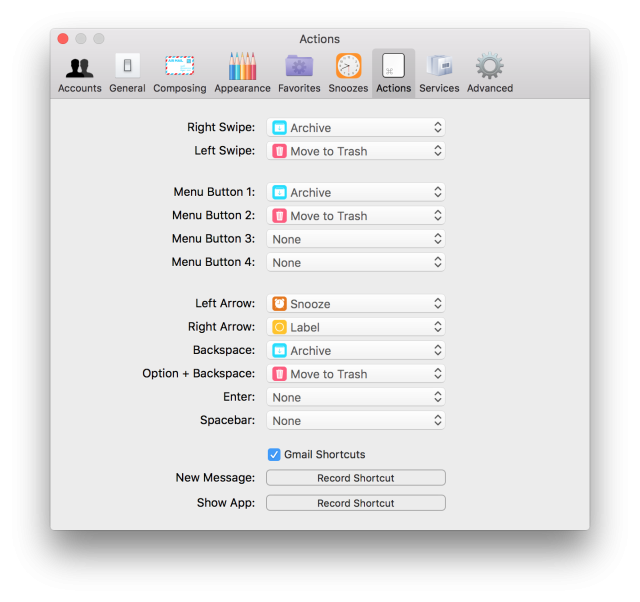
Now for the bad: Contacts
An e-mail client is only as good as its contacts. As with my other organizational applications, I prefer my contact application to be separate. But in this case, it's only because I need to access my contacts from my calendar and from my e-mail client. Since they are all talking to the same Exchange account, it shouldn't matter, right? But ever since I started using Airmail, I haven't been able to get it to access to the Exchange global address book. At least Airmail's support is pretty good—one quick trip to Airmail's online help and a 30 second chat with a help person later and the problem was solved. At least partially.
Yes, Airmail will extract addresses from the Exchange directory, but this is limited. For instance, if I use the Contacts application to create a group on the Exchange server and drop a bunch of contacts in it, Airmail will not notice. Instead, I have to ask Airmail to manually sync with the local copy of the Contact application's database. This is frustrating, and I hate it.
If you really like the combined e-mail, calendar, coffee maker, and lawnmower approach to applications, Airmail is not the e-mail client you are looking for. On balance, though, I like it. Airmail's not perfect, but it’s far better than all the others I've tried. It fits my workflow, doesn't crash, and doesn't silently stop receiving new e-mail (thanks Mail). With stronger integration with a contacts application or a better built-in contacts application, I'd be totally satisfied.
reader comments
175